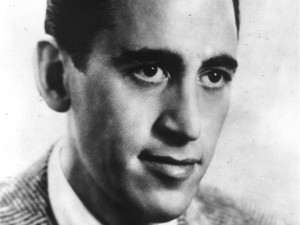J.D. Salinger Bio (1919-2010): Video Exclusive, News, Photos
J.D. Salinger Biography
Jerome David Salinger (January 1, 1919 – January 27, 2010) was an American writer and novelist famous not only for his early success or later reclusiveness but also for his authorship of Catcher in the Rye featuring the protagonist Holden Caulfield in a tale about of young adulthood that chronicles the universal feelings of alienation, isolation, and the loss of childlike naiveté that are the hallmark of everyone’s teenage years.
Salinger was born in Iowa to Sol Salinger who sold kosher cheese, and Marie Jillich who later changed her name to Miriam. He also had an older sister named Doris who passed away in 2001.
Like many writers, Salinger was listless but had a talent for drama and writing. Despite his listlessness, a trait shared by most writers, and despite his mediocre grades in school (again, a shared trait), Salinger was accepted into and dropped out of a number of colleges and ran through a number of jobs between New York and Vienna, Austria before settling into a Columbia writing class lectured by Whit Burnett who discovered Salinger’s talent and published his short story “The Young Folks” through Burnett’s magazine Story. Salinger was 21 at the time.
J.D. Salinger World War II Service
In between odd jobs and mixed attempts at getting more work published, Salinger dated Oona O’Niell (daughter of Eugene O’Neill); the relationship was brief but etched itself onto Salinger’s heart and mind. Shane Salerno, director of the 2013 documentary Salinger addressed that topic. “That relationship, which Salinger never recovered from, imprinted upon him a girl, not a woman, a girl at a very specific age, on the cusp of womanhood, and he was forever fascinated with girls at that age.”
From 1941 through about 1946, Salinger served in the military and saw action during the Second World War. He served in the 12th Infantry Regiment, 4th Infantry Division and saw numerous conflicts including D-Day. He also carried on a brief correspondence with Ernest Hemingway during this time; Hemingway, in turn, had referred to Salinger as having great talent.
J.D. Salinger Writing Career, Catcher in the Rye
After the war, Salinger spent some time hospitalized with combat fatigue, having been traumatized by things he had seen and experienced during the Battle of the Bulge and the numerous trench warfare encounters he’d had over the course of the war. Trauma, whether physical or existential, is often the fuel a writer uses to thrive, and during this period Salinger was prolific in his writing of both short stories and poems. While recovering, Salinger notably published two stories “I’m Crazy” (1945) and “Slight Rebellion off Madison” (1946); both feature Holden Caulfield who would later become the protagonist in his magnum opus, Catcher in the Rye in 1951.
Over time, certain literary works have survived their controversies—Johnny Got His Gun and The Marquis de Sade for example—Catcher in the Rye has remained infamous and continually under attack by a number of groups. While its content can be considered mild when compared to other works of fiction both before it and after it, the universal nature of the work has led to many interpretations that have led to tragic results. Stalkers and malcontents like Robert John Brando was enamored with the book when he took the life of actress Rebecca Schaeffer; John Hinckley, Jr. was obsessed with both Jodie Foster from Taxi Driver, viewed himself as Holden Caulfield and nearly succeeded in assassinating President Ronald Reagan; Mark David Chapman was found with a copy of the book on his person following his arrest for the murder of John Lennon.
Despite, or perhaps because, of the controversy that has steadily followed Catcher in the Rye in the decades since its release, Salinger’s novel has never gone out of print, selling a quarter of a million copies per year, and in its depiction of disaffected youth, stands almost as a guide to teenagers in any generation through the angst and isolation felt they feel during the transitory phase between childhood and adulthood. Its frank discussions of sex and sexuality, its coarse language and stark openness has guaranteed its place in popular culture, and also, in 2010, managed to outlive its creator.
Catcher in the Rye is now often taught in English classes as early as middle school in an attempt to show students that the feelings they have now are timeless but will eventually pass. This new role hasn’t diminished the controversies surrounding it, however. Since its publication, Rye has made it on banned books list, has been the focus of attacks by parents and religious groups that find its language and sexual content, even after fifty years, to be unacceptable and bordering on the pornographic. These protests have led to more libraries carrying the book, more printings made by publishers, more teachers assigning it, and more students hungry for the pages between the covers.
J.D. Salinger Marriages & Relationship With Joyce Maynard
Salinger was married for the first time to Sylvia Welter. They divorced two years later in 1947.
From 1955 to 1965, Salinger was married to Claire Douglas, with whom he had two children: Margaret and Matthew. It was during this time that Salinger had become a bit of a recluse and involved himself in multiple religions and belief systems including Kriya Yoga, Dianetics, Christian Science and Vedanta. Claire had been drawn into isolation with her husband, and did not take to it the way he did. Time magazine and her children both felt she had essentially become a prisoner of her own family and was at times disturbed; the pair divorced after ten years of marriage.
Salinger, his personal life now as enthralling as his fiction, had become a center for controversy as well, not only because of his strange reclusive nature but also because of his relationship with Joyce Maynard which lasted nine months. At the time, Salinger was 53 and Maynard was 18. They had exchanged correspondence, which was, as Maynard eventually learned, the way Salinger preferred to meet women. Their break-up, naturally, has two stories attached to it: Salinger claimed it was because Maynard wanted a family and Salinger himself felt too old for it while Maynard claimed it he had abruptly ended the relationship himself.
Salinger married one last time, to Colleen O’Neill in 1988. They remained together until his death in 2010.
J.D. Salinger: The Betty Eppes Incident
Salinger continued to write over the years and at the time of his death may have written up to 15 novels that have never been published. As stipulated in his will, his unpublished works will be released between 2015 and 2020 except for The Ocean Full of Bowling Balls due to an agreement with Princeton University stating it cannot be published until 2060 at the earliest. However, arrangements can be made to read a copy of the story in-house, and digital copies leaked online have made it readily available to anyone.
Salinger’s final interview was in 1980 and proved as controversial as anything else in his life by that point. His interviewer was Betty Eppes, then a young intrepid reporter for The Baton Rouge Advocate. There are two accounts of this interview: one that insists that Salinger knew Eppes was a reporter, the other that she lied, apparently using her youthful good looks and a lie about being a budding novelist as an excuse to get him to start talking. Likewise, the ending to this encounter is also up for review: it either ended abruptly when a passerby recognized Salinger or pleasantly which explains the numerous pictures Eppes took with the author. As with anything in good fiction, the truth is up to the reader to decide.
Shane Salerno Documentary: Salinger
Director Shane Salerno’s documentary Salinger provides an intimate look at and detailed insights into the life, work and legacy of J.D. Salinger. Salerno spent ten years carefully investigating, researching and accruing information on the late author, and the results were enlightening, spanning Salinger’s private and professional life, his beliefs and religious conversions, his relationships and family, the controversies and the lawsuits, the work we know and love, and the work we’ve yet to see. Of the unpublished stories, Salerno told uInterview: “I mean, no writer of J.D. Salinger’s size or weight has ever written for four and a half decades entirely for himself, only to publish that work posthumously. If the work delivers the signature Salinger voice, he’s going to have the greatest second act that any writer’s ever had in history.”
News
- Snubbing Robert F. Kennedy Jr., 15 Kennedy Family Members Endorse Joe Biden During A Campaign Rally
- Jenna Dewan Claims Ex-Channing Tatum Hid ‘Potential Billion-Dollar Asset’ In ‘Magic Mike’ Earnings During Divorce
- Musical ‘Lempicka’ Brings Thrilling Portrait Of An Artistic Icon To Broadway
- After Florida Leads Country In Public School Book Bans, Gov. Ron DeSantis Signs Bill To Limit Them
- EXCLUSIVE VIDEO: Bobby Lee & GaTa Look Reflect On Meaning Of Film ‘Sweet Dreams,’ Working With Johnny Knoxville
- Former Project Director Trump Golf Course In Scotland Says He Felt ‘Hoodwinked’ By Former President: ‘Scotland Fell For It’
- After Oscar Slap, Will Smith Makes His Return To The Stage With J Balvin At Coachella
- Doja Cat Sports Futuristic Look At Coachella 2024
- Judge Warns Donald Trump That He Will Be Arrested If He Disrupts Or Skips His New York Hush Money Trial
- ‘The Wiz’ Returns To Broadway With An All-Star Cast Including Wayne Brady & Deborah Cox
- Trump Attorney John Eastman Claims He Was Dropped By Two Banks Due To His Association With January 6 & Former President
- After Saying Trump Is Unfit To Be President, N.H. Gov. Chris Sununu Slammed On Social Media For Flip-Flopping & Endorsing Him
- Hillary Clinton & Kelly Clarkson Express Outraged Over ‘Insane’ Arizona Supreme Court Ruling Reinstating 1864 Abortion Ban
- Emma Roberts Turns Her $3.4 Million L.A. Home Into A ‘Grown-Up Doll House’
- Gwen Stefani & Olivia Rodrigo Rock The Stage At 2024 Coachella
- VIDEO EXCLUSIVE: Carol Kane Reflects On ‘Dinner With Parents,’ Her Favorite Comedy Roles
- Indicted Sen. Robert Menendez Ready To Throw Wife Under The Bus In Bribery Trial Defense, Court Filing Shows
- Ivanka Trump & Kids Enjoy Motocross Outing In Miami As Father Sits In NYC Court
- Right-Wing Broadcaster Clay Travis Encourages NYC Trump Supporters To Get On Ex-President’s Hush Money Jury & Refuse To Convict Him
- Courtney Love Says Taylor Swift Is ‘Not Important As An Artist,’ Doesn’t ‘Like’ Beyoncé’s Music
- Judge Accuses Trump Of ‘Intimidating’ A Juror After Former President Mutters At Him In Court
- GOP Senate Candidate Kari Lake Criticized For Telling Supporters: ‘Strap On A Glock’
- Peso Pluma & Becky G Perform In Sunglasses At 2024 Coachella
- ‘Absolute Queens’ Taylor Swift & Teresa Giudice Pose At Coachella
- Lisa Rinna Announces She’s Getting Face Injections Dissolved After Fans Roast Her For ‘Changed’ Look
Get the most-revealing celebrity conversations with the uInterview podcast!








Leave a comment